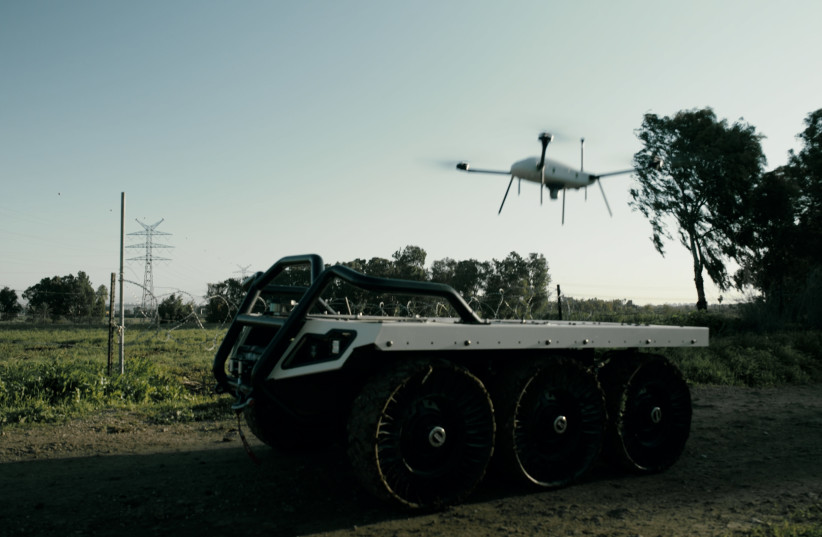Three Israeli defense companies are participating in the 5th annual Unmanned Systems Exhibition, or UMEX, starting Monday at Abu Dhabi’s National Exhibition Center.
The three-day event will also include the Simulation and Training Exhibition (SimTEX) and will see the participation of 134 exhibitors from 26 different countries.
Israel will be participating for the first time, along with Serbia, Austria, Bulgaria, Malta, Turkey and Bahrain. The Israeli companies taking part include Elbit Systems, Copterpix and Avnon HLS Group. In a statement, Avnon HLS Group said that it was “proud” to be participating in the exhibition, calling it “one of the most important regional exhibitions for unmanned systems.”
The company will be showcasing anti-drone solutions by Skylock (SkypFlair, Dronelock, Sky Interceptor, wearable solutions radar), and multi-sensor surveillance technology made by Beesense (Mantis3, Firefly140sv, Bee5), iStar’s VOTL UAV (Advance), and TAR’s Command and Control system.
The exhibition is organized by the Abu Dhabi National Exhibitions partnering with the Tawazun Economic Council, in cooperation with the United Arab Emirates’ Defense Ministry and supported by the UAE’s Armed Forces.

The exhibition is organized by the Abu Dhabi National Exhibitions partnering with the Tawazun Economic Council, in cooperation with the United Arab Emirates’ Defense Ministry and supported by the UAE’s Armed Forces.
While Israel’s Defense Ministry and state-owned companies will not be participating, other regional government delegations as well as industry, military and civilian authorities are expected to attend.
Dedicated to drones, robotics and other unmanned platforms, UMEX’s theme is “Unmanned, Unbound: Realizing the promise of the unmanned revolution” and will showcase unmanned systems technology and capabilities.
It will also have conferences which will discuss the latest developments, trends and innovations as well as live-flying exhibitions the Simulation and Training (SIMTEX) section that, according to the organizers, “will promote cooperation among the Armed Services, Industry, Academia and various Government Agencies in pursuit of improved training and education programs identification of common training issues and development of multi-service programs.”
Though Israel’s participation in UMEX is relatively small compared to other global exhibitions, including IDEX which took place late last year, it comes as the threat from armed drones launched by Iran and its proxies increased.
Iran has been building an army of unmanned aerial systems since 1984 and the fleet not only has a range of over 2,000 kilometers but has very advanced development and operational capabilities.
Iranian drones have been behind deadly and devastating attacks against targets at sea as well as at land in recent years.
In September 2021, Israeli Defense Minister Benny Gantz said that Iran’s drone fleet “is one of the most significant tools developed by Iran.”
It’s “an array of deadly, precision weapons that, like a ballistic missile or a plane, can cross thousands of miles. The Iranians produce and export these aircraft to their proxies, in coordination and led by the IRGC Air Force and Quds Force.”
According to Gantz, Iran is training militias from Iraq, Yemen, Lebanon, and Syria to operate and manufacture Iranian UAVs at Kashan Base north of the city of Isfahan, “the cornerstone of Iranian aerial terrorism in the region.”
The defense minister said that Iranian UAVs and other precision weapons are “key tools” that can hit strategic targets thousands of kilometers away and are “already endangering Sunni countries, international troops in the Middle East and also countries in Europe and Africa.”
Due to the increasing threat posed by UAVs, following the signing of the Abraham Accords, Israel has increased its military presence in Gulf States.
During Gantz’s visit to the Bahraini capital of Manama earlier this month he signed a Memorandum of Understanding that formalizes defense relations between the two countries, allowing for increased cooperation in various fields such as intelligence sharing,military-to-military training, cooperation between defense industries, and more.
At the ceremony, Gantz said that the MoU is a “significant security agreement” that will allow for extensive cooperation and will strengthen the security of both countries.
According to a report by Israel’s N12 News, Israel is building a regional detection array at Hatzor airbase with several countries in the area against drone attacks. The report said that the Israeli radar system could detect such threats for neighboring countries as well as help destroy them.
Israel’s Navy also participated in the large-scale International Naval Exercise (IMX) led by the US Naval Forces Central Command.
Over 9,000 personnel and up to 50 ships from more than 60 militaries and international organizations participated in the exercise that focused on unmanned naval systems and the use of artificial intelligence.
Several countries that recently normalized ties with Israel also took part in the drill including the United Arab Emirates, Morocco, and Bahrain. Several others who do not have formal ties are also participating including Bangladesh, Comoros, Djibouti, Oman, Pakistan, Saudi Arabia, Somalia and Yemen. Egypt and Jordan also participated.
Seth J. Frantzman contributed to this report.
